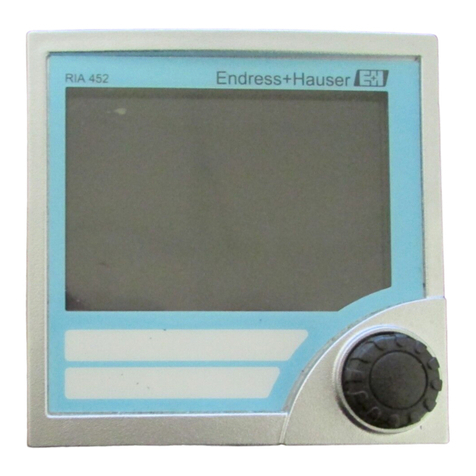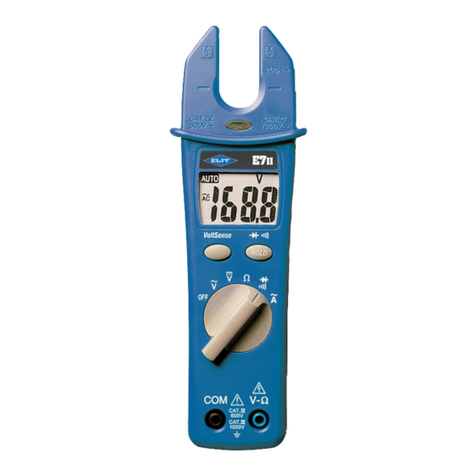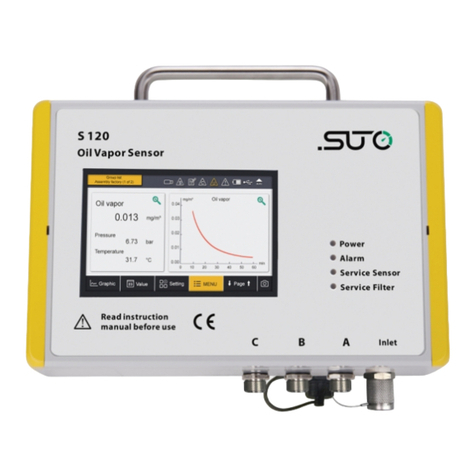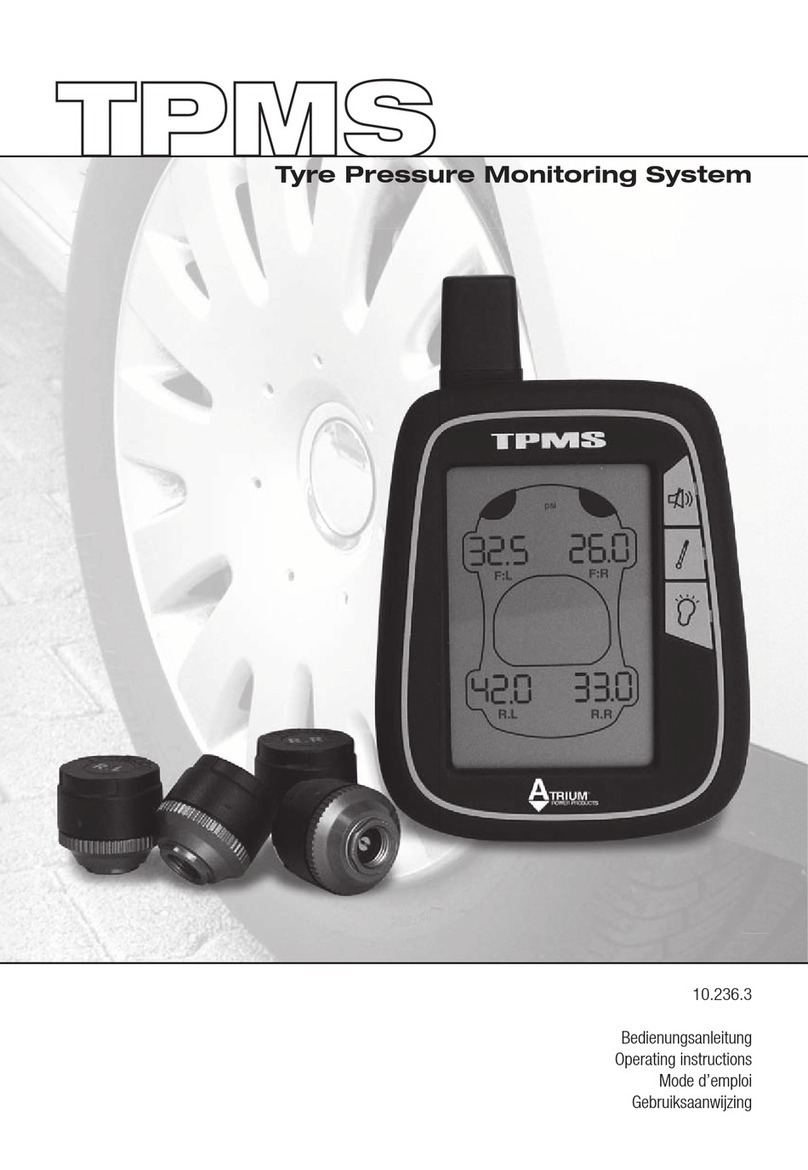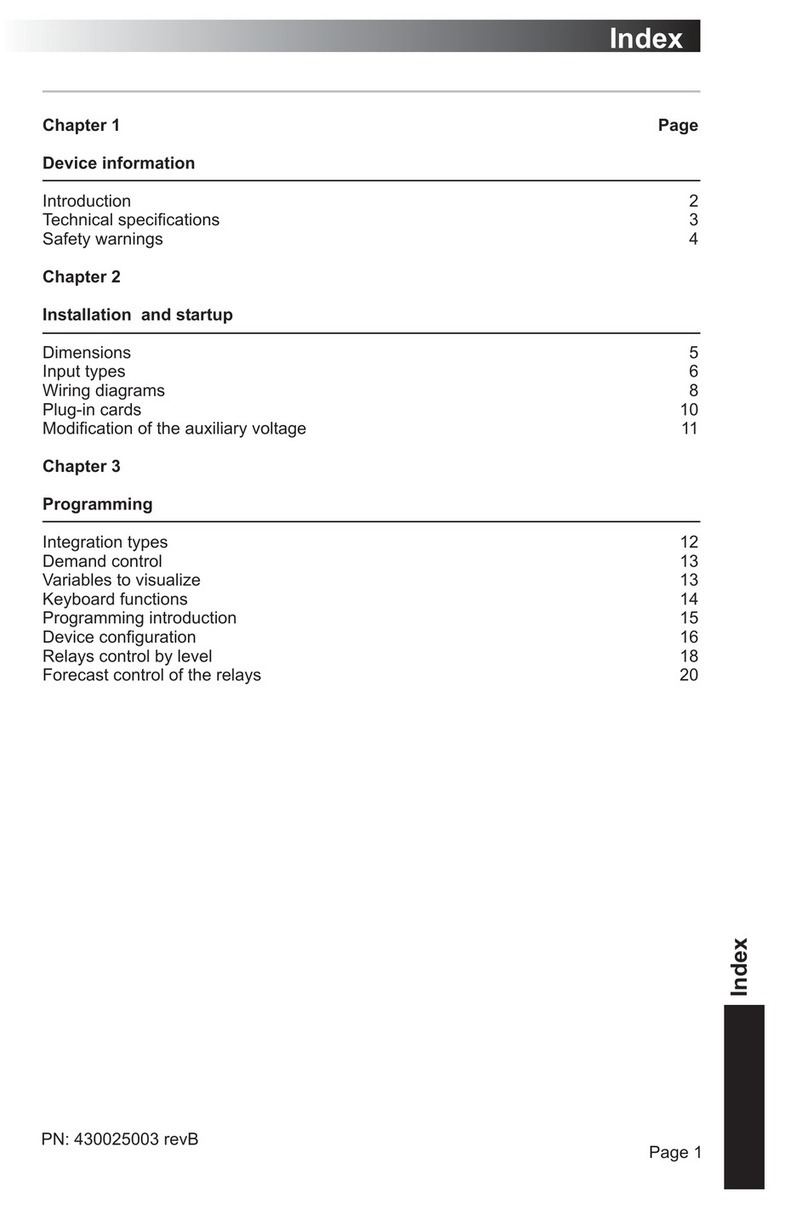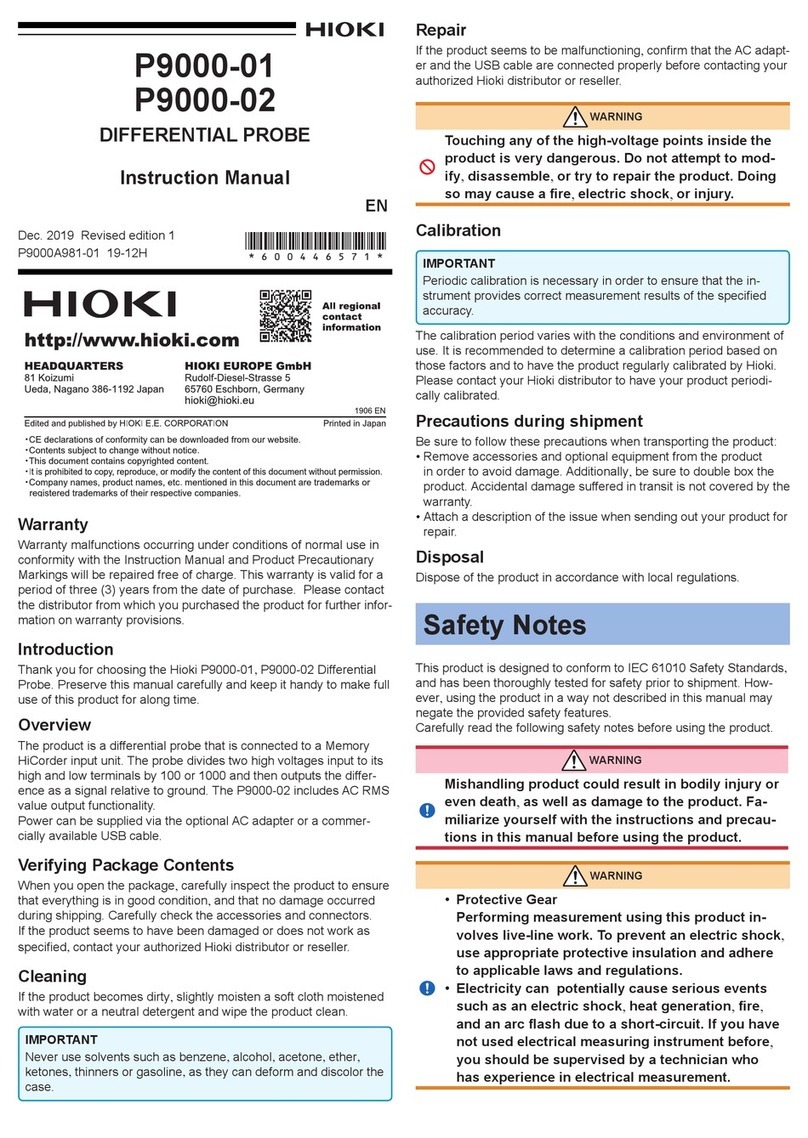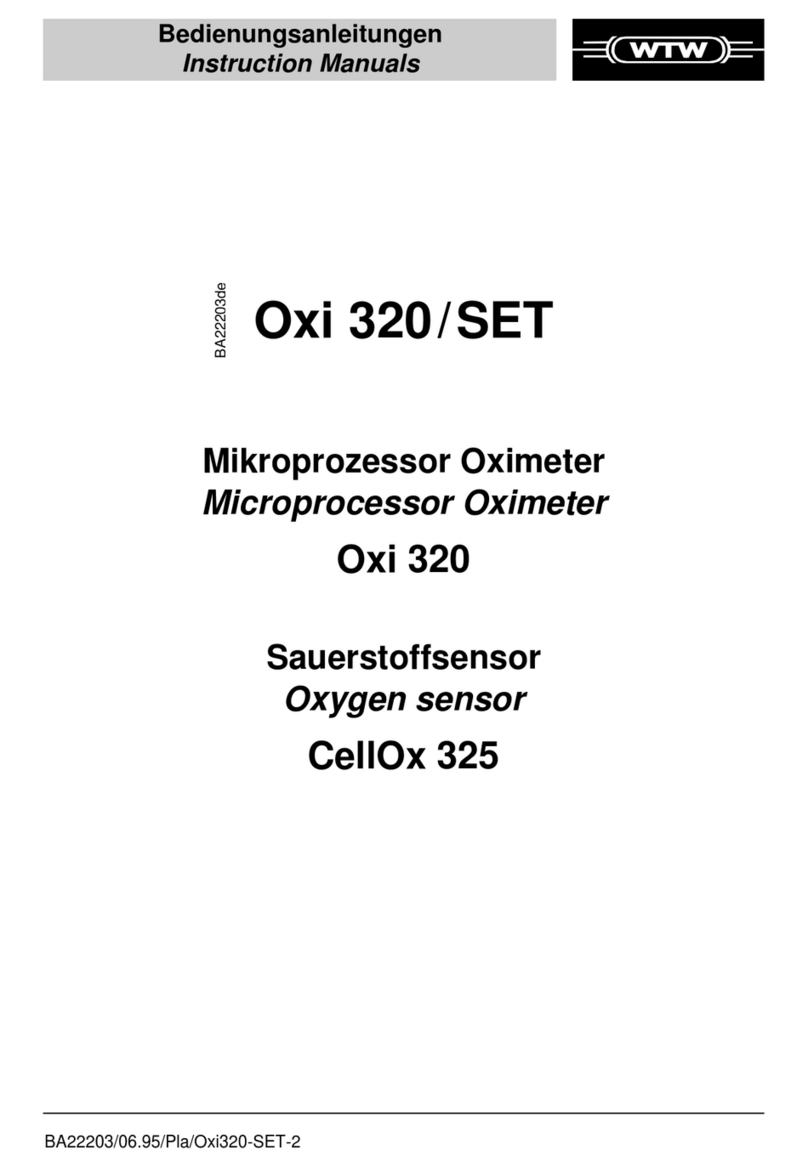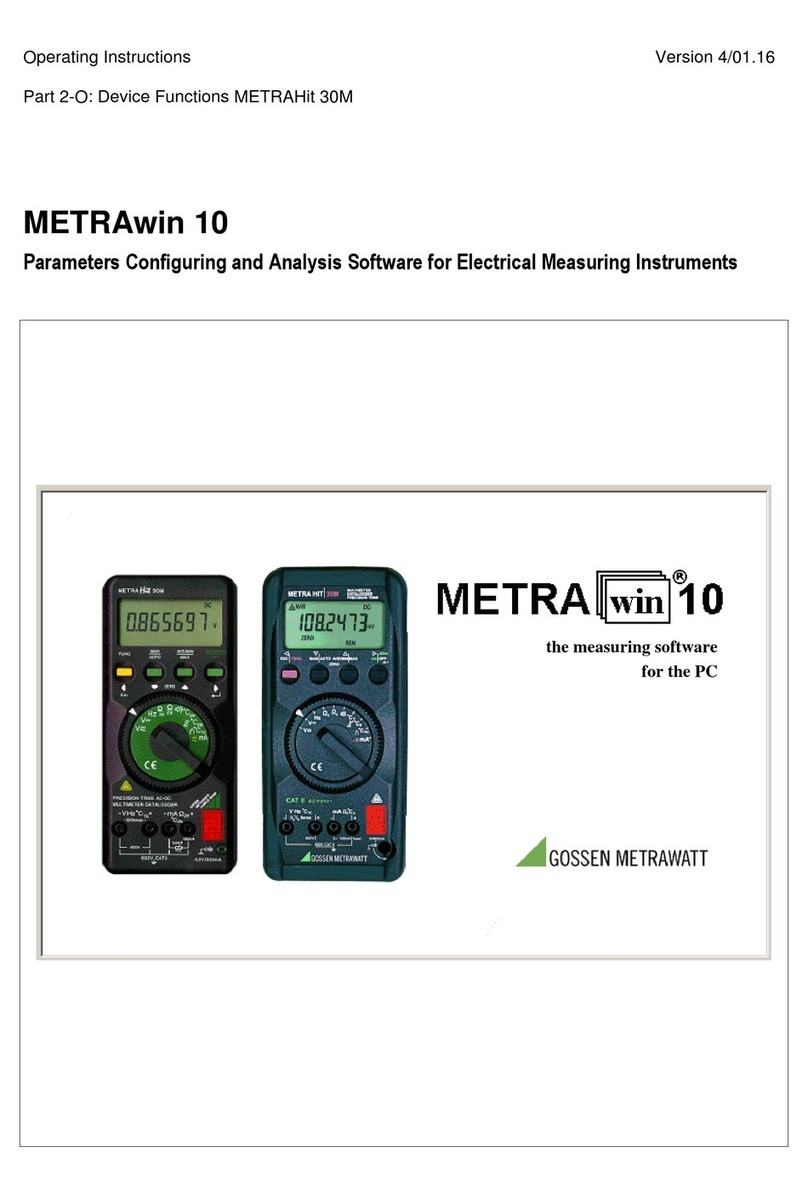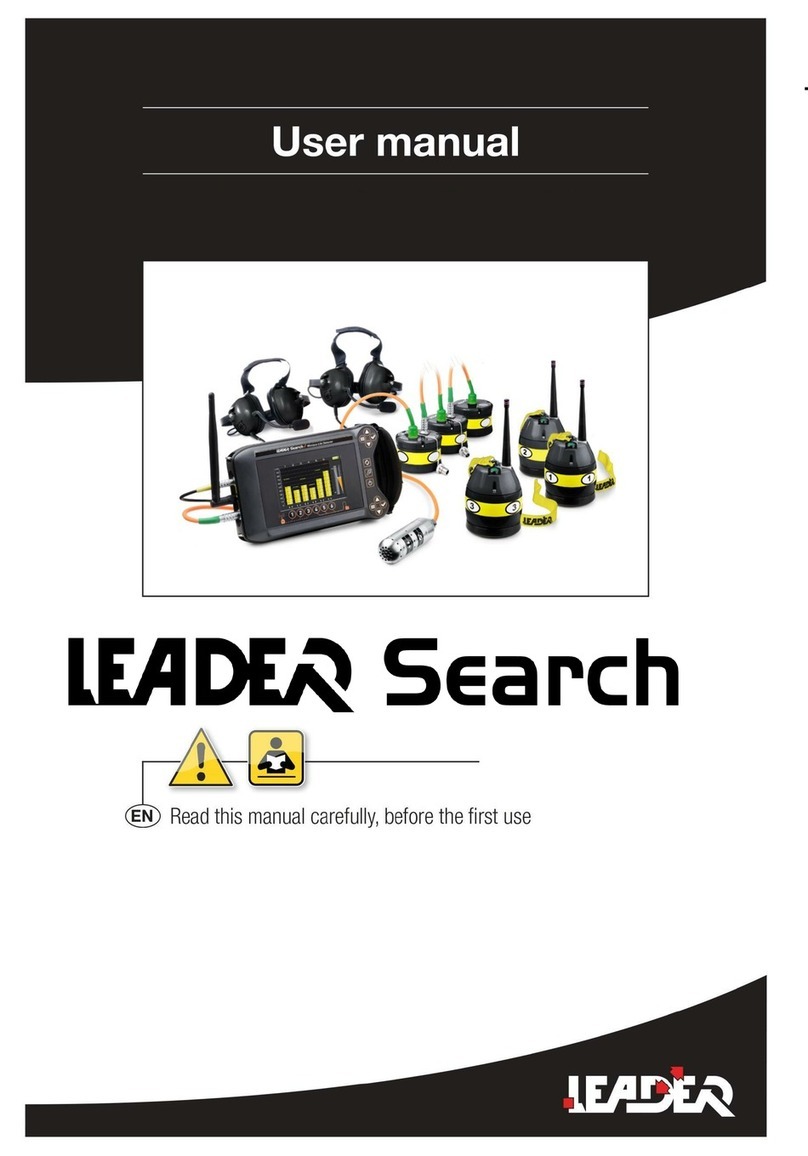Sensor Therm METIS M3F1 User manual

Pyrometer
METIS M3F1
With 12-pin connector, display and push button device configuration
User Manual

METIS M3F1
Content
2
Content
1General...............................................................................................................................................4
1.1 Information to this Manual.........................................................................................................4
1.2 CE Conformity and Standards..................................................................................................4
1.3 Limitation of Liability..................................................................................................................4
1.4 Terms of Warranty ....................................................................................................................4
1.5 Copyright...................................................................................................................................4
1.6 Explanation of Symbols ............................................................................................................5
1.7 Customer Service / Spare Parts ...............................................................................................5
1.8 Disposal ....................................................................................................................................5
2Safety..................................................................................................................................................6
2.1 General .....................................................................................................................................6
2.2 Electrical Connection ................................................................................................................6
2.3 Laser Targeting Light................................................................................................................6
2.4 Through-lens Sighting / View Finder.........................................................................................6
2.5 Device Labels............................................................................................................................6
2.6 Responsibility of the Operators.................................................................................................6
3Overview ............................................................................................................................................7
3.1 Intended Use.............................................................................................................................7
3.2 Scope of Delivery......................................................................................................................7
3.3 Model Designs ..........................................................................................................................7
4Electrical Connection........................................................................................................................8
4.1 Cable Colors and Pin Assignment (14 Wire Connection Cables).............................................8
4.1.1 Power Supply.......................................................................................................................9
4.1.1.1 Factory Settings..............................................................................................................9
4.1.2 Analog Output 1 and 2.......................................................................................................10
4.1.3 Configurable Inputs / Outputs............................................................................................10
4.1.4 Serial Interface RS232 / RS485 (switchable) ....................................................................11
4.1.4.1 Interface Converter (Accessory)...................................................................................12
4.1.5 Shielding ............................................................................................................................12
5Mechanical Installation...................................................................................................................12
5.1 Mounting .................................................................................................................................12
5.2 Mounting Optical Fiber / Optics (only devices with optical fiber) ............................................13
5.2.1 Bending Radius Optical Fiber............................................................................................13
5.2.2 Winding and Unwinding the Optical Fiber .........................................................................13
5.2.3 Mounting of Optical Fiber...................................................................................................13
5.2.4 Connect the Optics ............................................................................................................14
5.3 Ambient Temperature.............................................................................................................14
5.4 Measuring Technology............................................................................................................15
5.4.1 Alignment with the Laser Targeting Light ..........................................................................15
5.4.2 Alignment with the Through Lens Sighting / View Finder..................................................16
5.5 Setting the Measuring / Focus Distance.................................................................................16
5.5.1 Integrated Focusable Optics..............................................................................................16
5.5.2 Manually Focusable Fiber Optic Lenses............................................................................16
5.6 Spot Size Tables.....................................................................................................................17
5.6.1 Calculation of the Spot Size Diameter outside the Focused Distance ..............................17
6Configuring the Pyrometer.............................................................................................................18
6.1 Push Button Functions............................................................................................................18
6.2Parameters / Settings .............................................................................................................19
6.2.1 Soot Factor ........................................................................................................................20
6.2.2 Emissivity Slope (only when using the pyrometer as a usual ratio pyrometer).................20
6.2.3 Emissivity ε (only when using as a usual single-channel pyrometer)................................20

METIS M3F1
Content
3
6.2.4 Transmittance....................................................................................................................21
6.2.5 Spot Size Fill Factor...........................................................................................................21
6.2.6 Switch-off Level .................................................................................................................22
6.2.6.1 Switch-off Verification...................................................................................................22
6.2.7 Dirty Window Alarm ...........................................................................................................22
6.2.8 Response Time t90 .............................................................................................................22
6.2.9 Dynamic Adaptation at Low Signal Levels ........................................................................22
6.2.10 Maximum Value Storage (Peak Picker) / Clear Time tCL...................................................22
6.2.11 Temperature Sub Range...................................................................................................23
6.2.12 Customize Analog Output..................................................................................................23
6.2.13 Analog Output....................................................................................................................23
6.2.14 Test Current.......................................................................................................................23
6.2.15 Upscale-Burnout................................................................................................................24
6.2.16 Interface Type....................................................................................................................24
6.2.17 Baud Rate..........................................................................................................................24
6.2.18 Address..............................................................................................................................24
6.2.19 Temperature Unit...............................................................................................................24
6.2.20 Interface Delay / Answer Delay .........................................................................................24
6.2.21 Menu Lock .........................................................................................................................24
7SensorTools Software ....................................................................................................................25
7.1 Installation...............................................................................................................................25
7.2 Program Start..........................................................................................................................25
7.2.1 Connecting the Pyrometer.................................................................................................25
7.3 Software Window....................................................................................................................26
7.3.1 Main Window Graphs....................................................................................................26
7.3.2 Control Window .................................................................................................................28
7.3.3 Device Settings and Configuration ....................................................................................29
7.3.3.1 Configurable Inputs / Outputs.......................................................................................31
7.3.3.2 Data Collection (Buffer Mode)......................................................................................33
7.3.3.3 Single-Point Adjustment...............................................................................................34
7.3.4 Setups................................................................................................................................36
7.4 Data Playback.........................................................................................................................37
7.5 Communication / Options .......................................................................................................38
7.6 Spot Size Calculator ...............................................................................................................38
8SensorFlash Software (Update Firmware)....................................................................................39
9Technical Data.................................................................................................................................40
9.1 Storage ...................................................................................................................................41
9.2 Dimensions .............................................................................................................................41
9.3 Composition of the Type Number...........................................................................................42
9.4 Accessories.............................................................................................................................43
10 Maintenance.....................................................................................................................................44
10.1 Cleaning..................................................................................................................................44
10.2 Change Protective Glass at Manual Focusable Optics ..........................................................44
10.3 Pyrometer Calibration.............................................................................................................44
10.4 Trouble Shooting.....................................................................................................................44
11 Communication via Serial Interface / Interface Commands .......................................................45
Index.........................................................................................................................................................49

METIS M3F1
General
4
1 General
1.1 Information to this Manual
This manual enables the safe and efficient use with the device. The manual is part of the instrument and
has to be kept in a location where users always have access to.
Read this manual carefully before operating. For secure working all security notes and operation proce-
dures in this manual has to be followed.
Additionally the local accident prevention regulations and common safety regulations of the instruments’
operational area are valid.
The descriptions may differ from the current delivery status, since the pyrometer is continuously devel-
oped. Illustrations in this manual are for basic understanding and can differ from the actual construction.
1.2 CE Conformity and Standards
The product conforms to the following standards:
CE conformity: DIN EN 61326-1 (electromagnetic compatibility)
Laser safety: IEC 60825-1, laser class 2 (only devices equipped with laser targeting light)
RoHS: 2011/65/EU
1.3 Limitation of Liability
All information and notes in this manual are made under consideration of valid standards and rules,
state of technology and our expert knowledge for many years.
The producer assumes no liability for damages due to:
Non-observance of this manual
Usage out of intended use
Assignment of unskilled personnel
Unauthorized modifications
Technical modifications
Usage of spare parts not approved
The responsibilities of the delivery contract are valid as well as our general terms and conditions and
terms of delivery and the valid statutory rule at date of the conclusion of contract.
1.4 Terms of Warranty
A warranty period is 24 months from date of shipment form the Sensortherm facility. The seller will re-
pair or replace the device at its own discretion. Further claims of the buyer against the seller or its
agents are excluded, especially claims for damages that are not incurred in the delivery itself. This shall
not apply in cases of intent, gross negligence, or the absence of assured properties. Damage or misuse
of the product will be determined and void the warranty coverage. Repairs paid by the customer will in-
clude a 180 days warranty from date of shipment. Transportation costs are to be paid by the customer.
Any claims for damage caused by misuse, neglect or tampering with the sensor are excluded.
Sensortherm does not guarantee that the software is free of errors or programming errors.
1.5 Copyright
This manual is protected by copyrights and are intended solely for internal purposes.
It is not permitted to transfer these instructions to third parties, duplication in any kind and form - includ-
ing excerpts - as well as recovery and / or notification of contents without written permission of the man-
ufacturer, except are internal purposes.
Contraventions are liable for damages. All other rights reserved.

METIS M3F1
General
5
1.6 Explanation of Symbols
The following symbols are used in this manual for restrictions, preventive measures and security notes.
Please pay attention to these symbols for safety reasons.
WARNING: This combination of symbol and signal word indicates a potentially dangerous
situation that can lead to death or serious injury if not avoided.
CAUTION: This combination of symbol and signal word indicates a potentially dangerous
situation that can result in minor or moderate injury if not avoided.
CAUTION, LASER RADIATION: This combination of laser radiation symbol and signal
word indicates the dangers of a laser targeting light.
NOTE: This combination of symbol and signal word indicates a potentially hazardous situa-
tion that can lead to property and environmental damage if not avoided.
INFO: This symbol indicates useful tips, recommendations and information for efficient and
trouble free operation.
The identification label on top of the device contains the following infor-
mation: manufacturer, reference number, temperature range, serial num-
ber, serial interface output (=digital output), analog output, power supply,
country of manufacture and CE sign.
1.7 Customer Service / Spare Parts
For technical information contact our customer service.
It is recommended to purchase spare parts and accessories direct from Sensortherm (manufacturer).
In addition, our employees are always interested in new information and experiences arising from the
application and can be valuable for improvement of our products.
1.8 Disposal
Dispose of the product properly when it is no longer usable: pyrometers include electrical and electronic
waste and have to be recycled or disposed environmentally friendly or to send to the manufacturer for
disposal.
M3
F1 07501800058130423-A
Temp. Range: 750 - 1800 °C
1382 - 3272 °F
Serial #: 1234
Digital Output: RS 485
Analog Output: 2x 0/4 - 20mA
Made in Germany Power: 18 - 30V DC
Sensortherm GmbH

METIS M3F1
Safety
6
2 Safety
2.1 General
Any person who is tasked to carry out work with the device must have read and understood the operat-
ing instructions before beginning. Operation and maintenance of the system may only be performed by
trained personnel.
2.2 Electrical Connection
When connecting or when working on the mains voltage, the general safety guidelines are observed,
e.g. when connecting power transformers. Supply voltage can be lethal when touching. Improper instal-
lation can cause serious injury or physical damage. Only qualified personnel are allowed to work with
mains voltage.
2.3 Laser Targeting Light
For easy alignment, the pyrometers may be equipped with a laser targeting light, Laser Class 2 (ac-
cording to IEC 60825-1-3-4) and has a sticker shown on the right. The laser emits a visible red light with
a maximum power of < 1 mW and a wavelength around 650 nm.
Safety precautions:
Never look into the direct or reflected laser beam.
Do not point the laser to anyone.
If laser radiation hits the eye, the eyes must be intentional-
ly closed and the head immediately moved out of the
beam.
2.4 Through-lens Sighting / View Finder
Devices with through lens sighting and temperature range above 1400°C are equipped with an adjusta-
ble eye protection filter in the eyepiece to reduce glare at high measurement temperatures. The unpro-
tected look at temperatures >1400°C can damage the eyes function permanently.
Safety precaution: before looking toward the high temperatures, always first adjust the eyepiece with
help of a replacement light source by turning onto the darkest area. A safe method is the adjustment by
looking at a lamp.
2.5 Device Labels
On the top of the device there is the type label (nameplate) as well as a warning sticker for devices with
laser targeting light.
The device must be mounted in a manner that the labels after installation are still clearly visible.
Keep the warning signs in always legible condition
Replace damaged labels
2.6 Responsibility of the Operators
If the device is used in the commercial sector the operator is subject to the legal responsibilities for
workplace safety.
In addition to the safety instructions in this manual follow the regulations of safety, accident prevention
and environmental protection.
Laser
beam
direction
Laser warning label
on top of the device

METIS M3F1
Overview
7
3 Overview
3.1 Intended Use
The M3F1 is a special pyrometer of the Metis M3 series for non-contact infrared temperature measure-
ment of flames containing soot in coal-fired power plants, waste incineration plants and other combus-
tion furnaces.
3.2 Scope of Delivery
Pyrometer, software SensorTools, works certificate, user manual
(connection cables are not included in scope of delivery and have to be ordered separately).
3.3 Model Designs
Type label
Fiber optics
Mounting thread (M5) for
front mounting the pyrome-
ter or accessory
Mounting rail (bot-
tom of the device)
Connectors for power
supply, analog outputs,
serial interface, digital
inputs / outputs
Keypad
LEDs for monitor-
ing the operational
readiness or active
switching outputs
Models with fiber optics
Type label
Optics
Through-lens sight-
ing / view finder
Mounting thread (M5) for
front mounting the pyrome-
ter or accessory
Mounting rail (bot-
tom of the device)
Connectors for power
supply, analog outputs,
serial interface, digital
inputs / outputs
Keypad
LEDs for monitor-
ing the operational
readiness or active
switching outputs
Models with integrated optics

METIS M3F1
Electrical Connection
8
4 Electrical Connection
4.1 Cable Colors and Pin Assignment (14 Wire Connection Cables)
The electrical connection of the pyrometer (supply voltage and measuring signal) will be done via the
connector on the rear panel. For this purpose, pre-assembled connection cables are available as ac-
cessories (see 9.4 Accessories). To prevent accidental short circuits, cable wires not in use should be
secured to the supplied screw terminals.
Cable colors
Sensortherm
pyrometers
No.
Function
Pin
White
1
+ 24 V DC power supply (18–30 V DC)
K
E
DMH
J
L
C
BAK
FG
Connector pins
of the 12 pin
pyrometer connector
(view from outside)
Brown
2
0 V DC power supply (ground)
A
Green
3
+ Analog output 1 (0 / 4–20 mA)
L
Yellow
4
- Analog output 1 (0 / 4–20 mA)
B
White-green
14
+ Analog output 2 (0 / 4–20 mA)
D
Brown-green
15
- Analog output 2 (0 / 4–20 mA)
B
Grey
5
Digital input / output 1 1)
H
Pink
6
Digital input / output 2 1)
J
Blue
13
Digital input / output 3 / Analog in 1)
E
Black
9
RS232: RxD
RS485: B (+)
F
Grey-pink
11
Violet
10
RS232: TxD
RS485: A (-)
C
Red-blue
12
Red
8
DGND (ground for interface)
G
Orange
7
Shield (connect only for cable extension,
do not connect in the control cabinet)
M and plug housing
1) Reference potential 0 V, brown
NOTE: In general we recommend the use of the new 14 wire connection cables.
Be careful when using an old 12-wire connector cables (before 2015):
Connection cable for the previous models Metis and Sirius cannot be connected without re-
strictions on a M3 pyrometer!
Old connection cables are bridged in the cable connector to pins E-C and D-F. Connecting such a ca-
ble to a M3 pyrometer, serial interface and analog output 2 and digital input / output 3 are connected
and the galvanic isolation between the outputs is bypassing. Thereby the pyrometer is not destroyed,
but the functions are no longer available. Using such a cable only analog output 1 is available as output.
Cable colors
old Sensor-
therm cable
Function
Pins
White
Power supply +24 V DC
K
E
DMH
J
L
C
BAK
FG
Connector pins
cable socket (solder side)
Brown
Power supply 0 V DC (ground)
A
Green
+ Analog output (0/4–20 mA)
L
Yellow
- Analog output (0/4–20 mA)
B
Grey
Targeting light, external switch (bridge to K)
H
Pink
Maximum value storage, external clearing (bridge to K)
J
Orange
Screen
M
Red
DGND (Ground for interface)
G
Black
RxD (RS232) or B1 (RS485)
F
Violet
TxD (RS232) or A1 (RS485)
C
Grey / pink
RxD (RS232) or B2 (RS485) (bridge to F)
D
Red / blue
TxD (RS232) or A2 (RS485) (bridge to C)
E

METIS M3F1
Electrical Connection
9
M3
0 V
White
Brown
+24 V
LED 4:
Operating
status LED
4.1.1 Power Supply
With connection of the supply voltage (standard 24 V DC, possible range 18–
30 V) the unit is ready for operation with the following factory settings (changing
the settings is possible via the device keys (see 6,Configuring the Pyrometer)
or Software SensorTools (see 7). By connecting the power supply, the current
firmware version is displayed for a few seconds.
Interrupt the power supply to turn off the pyrometer, e.g. by disconnecting the
connector.
Operating status LED (4):
Orange in the self-test phase (approx. 2 s)
Green when the pyrometer is ready to operate
Red when an error occurred (see 10.4 Troubleshooting).
4.1.1.1 Factory Settings
Parameters Factory Settings
Display .................................................................. Flame temperature (display F)
Temperature sub range ........................................ Corresponds to basic range
Response time t90 ................................................. Min / 0,0 (corresponds to <1 ms)
Soot factor............................................................. 1.00
Emissivity slope .................................................... 1.000
Switch-off limit....................................................... 10%, hysteresis: 2%
Switch-off verification............................................ 10 ms
Emissivity ε (channel 1 and 2) .............................. 1.00 (corresponds to 100%)
Transmittance....................................................... 100%
Spot size fill factor................................................. 100%
Serial interface RS232 / 485................................. RS485
Data transmission speed (baud rate).................... 115.2 kBd
Buffer mode .......................................................... off (at “on”: buffer interval: 10 ms, single reading)
Device address ..................................................... 00
Interface delay ...................................................... 00 (for RS232 and RS485)
Maximum value storage........................................ off
Analog output 1..................................................... 4–20 mA, output temperature: measured temperature
Analog output 2..................................................... 4–20 mA, output temperature: no temperature output
Digital input / output 1........................................... set to input: no function
Digital input / output 2........................................... set to input: maximum value storage external clearing
Digital input / output 3 / Analog in......................... set to input: no function
Input debounce time........................................ 100 ms
Output activation time ..................................... 0 ms
Output hold time.............................................. 10 ms
Limit switch output........................................... center of temp. range °C / °F; hysteresis: 10°C / 20°F
Device over temperature................................. 50°C / 120°F; hysteresis: 2°C / 5°F

METIS M3F1
Electrical Connection
10
Max. 50 mA
0 V
M3
Output
+24 V
100 kΩ
White
Grey
Pink
Blue
Brown
0 V
M3 / H3
0...20 mA
4...20 mA
A
0...20 mA
4...20 mA
A
+IOUT1
-IOUT1
+IOUT2
-IOUT2
Green (+)
Yellow (-)
Brown-green (-)
White-green (+)
Note: The outputs are galvanically
isolated from the supply voltage.
4.1.2 Analog Output 1 and 2
The analog outputs are adjustable (e.g. for a temperature dis-
play device) to:
0–20 mA or 4–20 mA
Furthermore, the following adjustments can be done:
Analog output 1always provides the measured temperature
(always the temperature selected and displayed on the de-
vice display and the control window in SensorTools; see also
7.3.2 Control window).
(Note: With older firmware versions, the same settings are
possible as at analog output 2. A firmware update to the lat-
est version eliminates this possibility and prevents, that the output of analog output 1 is accidentally
different to the displayed temperature signal. Firmware update see section 8).
Analog output 2 can be assigned to provide different signals:
- Flame temperature
- 2-color temperature
- 1 channel temperature (optional channel 1 or 2)
- Device temperature
- Control output (= manipulated variable) when equipped with PID controller
4.1.3 Configurable Inputs / Outputs
3 ports are each available as:
Digital output: output of a switching signal (invertible, see under
7.3.3 Various settings Logic NO / NC) at:
- Device ready to operate (device ready and error-free after self-
test)
- Material detection (limit switch turns on when exceeding the
beginning of temperature range)
- Limit switch when a certain temperature threshold is exceeded
or falling below
- Exceeding the maximum allowed device temperature
- Signal strength too low (as dirty window alarm function: enables to detect the degree of contamina-
tion of the pyrometer‘s optics, viewing window or identify interferences (dust...) in the IR sensor’s
sight path and trigger an alarm if necessary).
Digital input: A voltage pulse of 24 V (exception: continuous voltage at "Activate controller"), pulse
length adjustable via software (minimum 3 ms, factory settings 100 ms) under 7.3.3 Configurable
Inputs / Outputs debounce time enables:
- Clear of peak picker (see 6.2.10)
- Load pyrometer configuration (devices with PID
controller also control parameters) (see under
7.3.3 Configurable Inputs / Outputs “pa-
rameter selector” or 7.3.4 Setups).
- Switch on / off laser targeting light (when
equipped with laser targeting light)
(the targeting light will automatically switched off
after 3 minutes if it is not switched off manually.
Adjustable via software under 7.3.3 Laser targeting light settings).
CAUTION, Laser Radiation, Laser Class 2:
Never look into the direct or reflected laser beam.
Do not point the laser to anyone.
If laser radiation hits the eye, the eyes must be intentionally closed and the head
immediately moved out of the beam.
M3 / H3
>10 kOhm
0 V
+24 V
Input 1-3
Push
button
0 V
+24 V
White
Grey
Pink
Blue
Brown

METIS M3F1
Electrical Connection
11
Analog input (only on input / output 3, adjustable via Software,
see Analog input): About a 0–20 mA current source, some pa-
rameters can be adjusted externally between their smallest and
largest setting value:
- Soot factor (0 mA = 0.5; 20 mA = 2.5)
- Emissivity slope (0 mA = 0.8; 20 mA = 1.2)
- Emissivity for every channel (0 mA = 0.05; 20 mA = 1.2)
4.1.4 Serial Interface RS232 / RS485 (switchable)
The serial interface is used for digital communication of the pyrometer with another computer, for exam-
ple a PC for data transmission to the software SensorTools. Via interface always all temperatures are
transferred (2-color and one channel temperatures) as well as device information and parameters.
The maximum transmission speed (in Baud) is limited by the cable length, it is halved with each dou-
bling of the transmission path.
RS232: about 7 m cable length with 19.2 kBd. Adjustable are values from 4.8 to 115.2 kBd.
RS485: about 2 km with 19.2 kBd. Adjustable are values from 4.8 to 921.6 kBd.
Connecting one pyrometer via
RS232 or RS485:
In a short RS232 or RS485 connection to the mas-
ter (computer receiving the data), the pyrometer is
connected directly as a point-to-point connection
with the master.
It is advantageous to connect all interface cables in
order to avoid reflections.
Connecting several pyrometers via RS485:
For a reflection-free operation with longer cables, pay attention to the correct cable termination. Termi-
nation at the physical bus is on front and rear.
Master at the
beginning:
Master in the
middle:
When operating multiple devices (up to 32 are possible), each device needs to assign its own address
(directly on the device or via software SensorTools), under which it can be addressed later. For this
purpose, initially, each device must be connected individually and provided with an address (00-97). Af-
ter that, all devices can be connected.
If specific parameters for all devices should be changed simultaneously, the global address 98 is used
(there is no response from the device). If the address of a device is unknown, you have the opportunity
to address each device independently of the set address with the global address 99 (connect only one
device).
Master
A (-)
B (+)
DGND
120 Ω
... Pyrometer n
Terminating
resistor 120 Ω
Pyrometer 2
Pyrometer 1
Terminating
resistor 120 Ω
in the master
or manually
A
B
GND
A
B
GND
A
B
GND
A
B
GND
B
A
B
A
120 Ω
... Pyrometer n
Terminating
resistor 120 Ω
Pyrometer 1
A
B
GND
B
A
B
A
120 Ω
Master
A (-)
B (+)
DGND
A
B
GND
Terminating
resistor 120 Ω
GND
RxD
TxD
GND
Pin 2
Pin 3
Pin 5
A (-)
B (+)
GND
RS485
(Master /
PC)
A (-) Red-blue
B (+) Black
B (+) Grey-pink
A (-) Violet
DGND Red
TxD Red-blue
RxD Black
RxD Grey-pink
TxD Violet
DGND Red
RS232 (PC)
Pyrometer
Pyrometer
Setpoint input
via external
0...20 mA
0 V
Current source
M3
Blue
Brown
≤300 Ω

METIS M3F1
Mechanical Installation
12
4.1.4.1 Interface Converter (Accessory)
A quick and easy way to connect the
pyrometer with a PC is to use an inter-
face converter or a connecting cable
with integrated interface converter (see
9.4 Accessories). Depending on the
operating system, suitable drivers are
installed automatically or can be found
on the CD supplied with the software
SensorTools in the directory Drivers FTDI_USB_COM, or after installing SensorTools in the installa-
tion directory (updated driver for Windows from the FTDI website:
http://www.ftdichip.com/Drivers/VCP.htm).
To achieve the maximum transfer speed, it is absolutely necessary to change the latency time in the
advanced connection settings from 16 ms to 1 ms (settings in the Control Panel device manager
Ports (COM & LPT) USB Serial Port Port Settings Advanced Latency Timer (at BM options)).
More information is available in the FTDI application note AN_107 - Advanced Driver Options.
4.1.5 Shielding
Orange: To meet the requirements for electromagnetic compatibility (EMC), only shielded cables
should be used. The shield of our connection cable is connected to the pyrometer side in the plug hous-
ing, on side of the connecting wires (voltage source) it remains open to prevent ground loops.
5 Mechanical Installation
5.1 Mounting
The mounting rail on the bottom case is for the stable take-up of for exam-
ple of a ball and socket mounting.
Front M5 threaded screws can also be used for mounting (all 4 threads has
to be used for fixing).
Note that the installation of the pyrometer is free of vibrations, if necessary,
helps the use of rubber absorbers when mounting.
To keep the optical fiber ready for use as long as possible, it should be ex-
posed as little as possible to permanent movement and mechanical stress.
Lay the optical fiber as possible with a large bending radius, especially if it is
carried along moving parts.
During installation of the optical fiber, it is advisable that both plug ends are
not yet connected to the pyrometer and the optics. Tensile and torsional stresses are to be avoided.
INFO: Through manufacturing tolerances the optical and mechanical axis are not running
100% in the same direction. The pyrometer should be realigned if it is installed again and twist-
ed in the same holder (see 5.4.2 Alignment with the view finder).
Cable colors
Metis M3 / M3F1
(12-pin connector)
Cable colors
interface converter
RS232USB (TxD / RxD)
RS485USB (A‾ / B+)
Red (GND)
Black (GND)
Grey-pink / black (B+/ RxD)
Orange (B+/ TxD)
Red-blue / violet (A‾ / TxD)
Yellow (A‾ / RxD)
Expl.: Metis with swivel
mounting base, cooling
plate and air purge

METIS M3F1
Mechanical Installation
13
5.2 Mounting Optical Fiber / Optics (only devices with optical fiber)
5.2.1 Bending Radius Optical Fiber
The color code on the optical fiber identi-
fies the optic diameter and minimum bend-
ing radius associated.
When laying the optical fiber it is to ob-
serve the minimum bending radius. A
bending radius smaller than specified can
cause a stretched or broken optical fiber.
5.2.2 Winding and Unwinding the Optical Fiber
Always ensure that the minimum bending radius is not exceeded.
During winding and unwinding the optical fiber must be able to move easily
and should not be twisted. Ideally, one hand winds up the light guide careful-
ly, while the other hand guides the cable roll. For torsion-free winding only
one side of the optical fiber should be connected, than the other can be
moved freely.
NOTE: Strong tensile and torsional forces during rolling and
mounting should be avoided.
5.2.3 Mounting of Optical Fiber
Assignment fiber to pyrometer and optics: Each fiber is uniquely associated to a pyrometer and op-
tics. For identification, all three components are tagged with the same device number. The measure-
ment accuracy can
only be guaranteed
with proper as-
signment.
INFO: To meet the high accuracy, the instrument should be recalibrated when replacing an
optics or the optical fiber.
NOTE: To prevent the ingress of dirt, remove the protective caps from the pyrometer and op-
tics and fiber just before installation.
Keep the protective caps to be able to protect against dirt in any subsequent dismantling or
storage.
Color code
of the optical fiber
Fiber diameter
Minimum
bending radius
Blue
0.4 mm
150 mm
Red
0.2 mm
75 mm
White
0.1 mm
38 mm
Color mark
Connector pyrometer’s side
(turn protected)
Ambient temperature on
pyrometer’s side max. 100°C
Ambient temperature on
optics side max. 250°C
Connector optics side

METIS M3F1
Mechanical Installation
14
The optical fiber has to be mounted true sided:
The colored heat shrink tube marker matches to
the pyrometer side.
The optics fit on the side without marking
Unscrew the light guide protective tube from the
pyrometer’s housing
Pull the protective tube somewhat about the light
guide on the colored side to avoid pulling it over
the complete fiber after fiber assembly.
Remove the protective caps from the pyrometer
and optical fiber, insert the side with the turn pro-
tected fiber connector to the pyrometer, and make sure
that pin and recess snap together.
Tighten lock nut hand-tight (do not use a tool, otherwise
the screw or optical fiber can be damaged).
Finally screw the protective tube back on the pyrometer
housing.
5.2.4 Connect the Optics
Remove the protective caps from optical fiber and
optics
The fiber-optic connectors on the side of the optics
does not require special adjustment and is just
plugged and screwed
Tighten lock nut hand-tight (do not use a tool, other-
wise the screw or optical fiber can be damaged).
5.3 Ambient Temperature
The M3F1 is designed for ambient temperatures between 0 and
80°C. Operation outside this temperature leads to incorrect meas-
urements and may damage the unit.
Fiber optic devices can be exposed on optics and optical fiber to
ambient temperatures between -20 and 250°C without cooling, for
the housing the same temperatures apply as for standard devices (0–80°C).
To comply with the permitted ambient temperature sufficient distance from the (hot) measuring object is
observed.
The internal housing temperature can be read out via the software SensorTools (see 7).
It is also possible to configure one of the digital (switching) outputs in such a way that a correspond-
ing signal is switched if exceeding the maximum temperature (see 4.1.3 Configurable Inputs / Out-
puts and under 7.3.3 Configurable Inputs / Outputs configuration).
Accessory: With radiant heat from the front, the pyrometer can be protected by a cooling plate. The
use of the pyrometer in ambient temperatures outside the permissible pyrometer’s ambient temperature
is possible with an additional cooling housing.
DT: internal de-
vice temperature
via software
Recess
Pin
Lock nut
Opt. fiber
Protective tube
Color mark

METIS M3F1
Mechanical Installation
15
5.4 Measuring Technology
The M3F1 is designed for non-contact temperature measurement of sooting flames in coal fired power
plants, waste incinerators and other combustion furnaces. It has been developed based on our 2-color
pyrometer M311 and uses a measuring method based on a special algorithm, which calculates the
flame temperature from the 1-color and 2-color temperature of the pyrometer. Necessary is the pres-
ence of soot particles in the flame, the corresponding soot factor can be entered via software Sensor-
Tools (see chap. 7) or via interface command (see chap. 11).
Additionally to the flame temperature, the 2-color and 1-color temperature can be displayed or activated
to the output simultaneously, that are used for calculating the flame temperature.
To detect the temperature correctly, the pyrometer must be properly aligned to the measuring object. In
the focus point of the optics (focus distance) the spot size diameter is the smallest. Also measurements
in the defocused area can be done to determine the average temperature of a bigger spot.
To get a correct measurement result, the following requirements must be observed:
For measurements through window, the window material has to be observed. If the transmission
properties are not uniform (e.g. quartz glass), the corresponding emissivity slope has to be entered.
If the target is smaller than the spot size, less signal strength arises to the pyrometer. If this falls be-
low 2%, a measurement is no longer possible (see 6.2.6 Switch-off Level).
5.4.1 Alignment with the Laser Targeting Light
The laser targeting light is a conical red laser beam with
the largest diameter directly at the lens and the smallest
and sharpest in the focused distance, i.e. at the point
where the measuring field is the smallest.
The focus distance (=measuring distance at the smallest
spot size) is easy to find where the laser dot is the small-
est.
INFO: The size of the laser point does not match to the spot size, spot sizes are given in the
spot size tables (see 5.6).
CAUTION, Laser Radiation, Laser Class 2:
Never look into the direct or reflected laser beam.
Do not point the laser to anyone.
If laser radiation hits the eye, the eyes must be intentionally closed and the head immedi-
ately moved out of the beam.
Turn on / off: Via the targeting light button on rear panel or via software
SensorTools (see 7.3.2,Control window).
(The targeting light will automatically switched off after 3 minutes if it is
not switched off manually. Adjustable via software under 7.3.3 Device
Settings Laser targeting light settings)
INFO: The laser targeting light is turned off at a device
temperature above 60°C.
If the targeting light does not turn on, probably the device's
internal temperature is too high. In this case, the place of instal-
lation of the pyrometer should be checked (excessive heat radi-
ated from the measuring object). When temperature falls below
60°C the laser is working again.
Laser target-
ing button
Software
Spot size and
laser point larger
Focus point

METIS M3F1
Mechanical Installation
16
5.4.2 Alignment with the Through Lens Sighting / View Finder
The view finder provides upright imagery so that the target under
measurement can be viewed visually. A target circle shows the
measuring spot when the target is in focus.
The M3F1 is equipped with a continuously adjustable eye protection fil-
ter in the eyepiece to reduce glare at high measurement temperatures.
Rotating the eyepiece will change the brightness.
INFO: The size of the target circle does not match to the spot
size, spot sizes are given in the spot size table (see 5.6).
CAUTION, Danger of eye damage at measuring temperatures above 1400°C!
To protect the eyes at high measuring temperatures, first, before alignment, the eyepiece
must be adjusted to the darkest position, a safe method is the adjustment by looking at a
replacement light source, e.g. a lamp.
5.5 Setting the Measuring / Focus Distance
The focal distance is the distance at which the lens has the smallest spot size. In most cases, this dis-
tance is also the required measuring distance.
With focusable optics the focus distance can be changed continuously within a predetermined range,
so the smallest possible spot size is always achieved.
5.5.1 Integrated Focusable Optics
To release optics, rotate counterclockwise
Move optics in or out until the measured distance is found (see 5.4
Measuring Technology or via the optics pull-out in the Spot Size
Tables, section 5.6).
- Pulled optics: short measuring distance
- Inserted optics: long distance measurement
Lock optics turn clockwise (hand-screwed, without tools).
5.5.2 Manually Focusable Fiber Optic Lenses
Optics OL25: Just slightly open the lens locking ring for re-
leasing and locking the optics, as rear optics part rotates with
opening of the locking ring.
Optics OL12: Optics lock screw (allen screw) for releasing
and locking the optics.
Pull the rear optics part out of the tube to focus according to
the required measuring distance (laser beam is focused and
has the smallest diameter).
NOTE: Never pull on the flexible part of the light
guide to focus!
1. Release
2. Adjust
3. Lock
1
2
3
View finder
Lens locking ring
Rear optics part
Optics lock screw
Resistant part of
the optical fiber
Focus
adjustment
Tube
Flexible part of the
optical fiber

METIS M3F1
Mechanical Installation
17
5.6 Spot Size Tables
The following tables show the optical data of the different device types. The values in the tables are ex-
emplary, intermediate measurement distances must be determined by interpolation. If the measuring
distance differs from the adjusted or specified, a measurement is also possible, but the spot size
changes (usually it is larger, see 5.6.1 Calculation of the spot size diameter outside the focused
distance). Measuring distances are specified from lens front.
Integrated
optics
Meas.
distance
a [mm]
Optics
pull-out
S [mm]
Spot size
diameter
M [mm]
Fiber optics
25 mm
Measuring
distance
a [mm]
Spot size
diameter
M [mm]
OQ11-A1
340
26
0,8
OQ25-B1
240
1
400
20,7
1,3
400
2
500
15,5
1,5
500
2,5
600
11,7
1,8
600
3
800
7,7
2,3
800
4
1000
5,5
2,8
1000
5
1500
2,7
4,6
1500
7,5
2000
1,3
5,8
2000
10
2500
0,5
7,3
2500
12,5
3000
0
7,8
3000
15
Aperture diameter D: Full scale temperature value
≤ 1400 °C: 14-16 mm; > 1400 °C: 7-8 mm
Aperture Ø D: 10-13 mm
(D is dependent on the optics pull-out: optics pulled out: higher value, optics inserted: smaller value)
5.6.1 Calculation of the Spot Size Diameter outside the Focused Distance
The spot size diameter determines the area on the measurement object from which 90% of the temper-
ature radiation is detected by the pyrometer; therefor the spot size tables specify spot sizes for different
measuring distances (or focused distances).
For calculating intermediate values in front of and behind the focused measuring distance, the following
formula can be used or the spot size calculator integrated in SensorTools (see 7.5):
a Focused distance
M Spot size diameter in the focused measuring
distance
a1Measuring distance longer than focused
measuring distance
M1Resulting spot size on measuring distance a1
a2Measuring distance shorter than focused
measuring distance
M2Resulting spot size on measuring distance a2
D Aperture (specifies the spot size directly on
the objective lens, it differs depending on the
optics pull-out. The largest value applies at a fully extended optics, the lowest value is with inserted
optics)
M
M2
M1
a2
a
a1
M1= (M+D)-D
a1
a
M2= (M-D)+D
a2
a

METIS M3F1
Configuring the Pyrometer
18
Display
LEDs
6 Configuring the Pyrometer
To configure the pyrometer (adapt to the measuring task and configure the connections), use the control
buttons on the back of the instrument.
When connected to a PC, all settings can be done via the supplied software SensorTools (see 7, Sen-
sorTools Software). The digital inputs / outputs can only be set via software.
Further it is possible to communicate via interface commands directly to the pyrometer (see 11, Inter-
face commands). The commands can be used for writing an own control or can be entered via a termi-
nal software.
Display in measuring mode
F: 1067.0°C Current (flame) measuring temperature (example)
F: ––––measuring temperature is below beginning of temperature range
F: OVER Measuring temperature is above the end of temperature range
––––––––––Device display set to „suppressed“ (see 7.3.3)
LEDs 1,2,3 (active digital outputs)
Green: Indicates an activated digital output
(see 4.1.3 Configurable inputs / outputs).
LED 4 (operating status LED)
Orange: During initialization and self-test phase (approx. 2 s)
Green: The unit is ready for operation
Red: in case of a device error
6.1 Push Button Functions
Parameter: Press the button repeated to get access to all settings sequentially (see 6.2,Pa-
rameters / Settings). If a subcategory is found, this is indicated with a > (e.g. MEASPARA.>).
Pressing ENTer the subcategories are called.
Arrow keys: Settings can be done with the arrow keys. Keep the button pressed to change
the values faster, reasonable for example when changing a temperature value. A changed
value is shown by a blinking display and will only be saved when pressing “Enter”, pressing
PAR calls the next parameter point.
If 60 seconds of inactivity have been made, the display jumps back to the measurement dis-
play without taking over any modified values.
Enter: opens a parameter category or takes over a modified parameter value.
Key lock: Press the arrow keys and the ENTer key simultaneously for approx. 3 s
to activate or deactivate the key lock. With locked keys, no parameters can be
called and changed.
Laser targeting light (depending on configuration): Turns on and off the laser targeting light.
CAUTION, Laser Radiation, Laser Class 2:
Never look into the direct or reflected laser beam.
Do not point the laser to anyone.
If laser radiation hits the eye, the eyes must be intentionally closed and the head immedi-
ately moved out of the beam.

METIS M3F1
Configuring the Pyrometer
19
6.2 Parameters / Settings
The table shows the adjustable parameters in order they appear on the pyrometer, detail description in
the next chapters.
Parameters
Meaning
Settings
DISPLAY>
Measuring temperature on the device display:
flame temperature F, 2-color temperature (2C), tem-
perature channel 1 (C1, longer range), channel 2 (C2,
shorter range) or sum channel 1+2 (CƩ)
F, 2C, C1, C2, CƩ
MEASPARA.>
Measurement parameters
–
T90
Response time t90
MIN / 01 ms–10.0 s
STMODE
Storage mode peak picker:
peak picker off, with time clear (TIME, time settings
under CLR), extern cleared (EXT), automatic cleared
(AUTO), with trigger function (TRIG)
OFF / TIME / EXT. /
AUTO / TRIG
CLR
Clear time settings with STMODE set to time clear
(only if STMODE set to TIME)
OFF / 01 ms–25.0 s
SOOT
Soot factor
0.50-2.50
SLO
Emissivity slope Ɛ2/Ɛ1
0.800–1.200
SW.OFF
Switch-off limit
2.0–90.0%
Ɛ1
Emissivity channel 1
0.050–1.200
TR1
Transmittance channel 1
5.0–100.0%
Ɛ2
Emissivity channel 2
0.050–1.200
TR2
Transmittance channel 2
5.0–100.0%
Ɛ12
Emissivity sum channel 1+2
0.050–1.200
T12
Transmittance sum channel 1+2
5.0%–100.0%
FF
Spot size filling (fill factor)
5.0–100.0%
ZSC
Zero scale temperature (beginning of temp. sub range)
e.g. 0400°C
FSC
Full scale temperature (end of temperature sub range)
e.g. 1300°C
TU
Temperature unit °C / °F
CELSIUS /FAHREN.
OUTPUTS>
Analog outputs
–
ANALOG>
Settings of analog output
–
A1
Analog output 1, current output
0–20 mA / 4–20 mA
A1TST
Test current (10 mA at 0-20 mA, 12 mA at 4-20 mA)
(not available if A1OUT is set to OFF)
OFF / 10 mA or 12 mA
A2
Analog output 2, current output
0–20 mA / 4–20 mA
A2OUT
Signal of analog output 2: off, flame temperature (F), 2-
color temperature (2C), temperature channel 1 (C1),
temp. channel 2 (C2), device temp. (DTMP)
OFF / F / 2C / C1 / C2 /
DTMP
A2TST
Test current (10 mA at 0-20 mA, 12 mA at 4-20 mA)
(not available if A2OUT is set to OFF)
OFF / 10 mA or 12 mA
INTERFACE>
Serial interface
–
RSTYP
Serial interface type
232 / 485
BD
Baud rate
4.8–115.2 kBd (RS232)
4.8–921.6 kBd (RS485)
ADD
Address
00–97
DELAY
Delay
00–20
MISC>
Miscellaneous settings
LG
Language
ENGLISH / DEUTSCH
N.PIN
Set (new) pin for push button lock
OFF / 0000–9999
FACT.SET
Reset to factory default settings
N / Y

METIS M3F1
Configuring the Pyrometer
20
Note:
These settings are available with the latest firmware. Missing settings in your device can be added by
updating the device firmware. By connecting the power supply, the current firmware version is displayed
for a few seconds, a firmware update is possible with the Software SensorFlash (see 8).
6.2.1 Soot Factor
The M3F1 measures the radiation by glowing soot and fuel particles of hot, CO2containing flames. The
different characteristics of the radiating soot particles can be taken into account by entering a soot fac-
tor. About software or interface command are input from 0.50-2.50 possible (equivalent to 50-250% in
0.1% increments).
6.2.2 Emissivity Slope (only when using the pyrometer as a usual ratio pyrometer)
When using the pyrometer as a ratio pyrometer, possibly the emissivity slope must be considered, ac-
cording to the material to be measured.
Measuring objects that emit the same on the two wavelengths of a 2-color pyrometer are often referred
to as "Gray bodies" (e.g. well oxidized iron or steel surfaces). They can be measured accurately with the
setting 1.00 for the emissivity slope without correction.
Measuring objects whose emissivity is different on the two wavelengths of the pyrometer (e.g. shiny un-
oxidized metal surfaces) need for accurate temperature measurement a correction setting, the so-called
emissivity slope Ɛ2/ Ɛ1. The value can be larger or less than 1, depending on whether the emissivity of
channel 1 or 2 is higher (gain from 1.000 to 0.800, attenuation from 1.000 to 1.200).
Regardless of emissivity slope 1 or above or below is
used to measure, the ratio must remain constant in the
required temperature range. In the software Sensor-
Tools the 2-color temperature and those of the two
channels can be displayed at the same time. A 2-color
measurement is possible if the curves of the two chan-
nels in the required measuring range run uniformly par-
allel, so the ratio is constant. If the temperature values of
the curves are identical (at the same emissivity setting),
then the emissivity slope is 1. Do they run parallel, so
the correct value for the emissivity ratio must be found,
such by comparative measurement with a thermocouple
and subsequent ratio setting until the temperatures match.
6.2.3 Emissivity ε (only when using as a usual single-channel pyrometer)
The pyrometer also can be used in single-channel mode, the measurement corresponds to that of a
conventional radiation pyrometer. In this measuring mode the input of an emissivity is necessary.
The emissivity indicates the radiation capacity of an object to be measured relative to a calibration
source with the same temperature. To obtain correct readings, the emissivity must be taken into ac-
count in the measurement and adapted for the respective measuring material on the pyrometer. Each
material has a max. emissivity of 1.00 which can be set, an adjustment of up to 1.20 can be used. The
emissivity adjustment above 1.00 allows for temperature corrections due to higher background reflec-
tion.
In principle applies: to measure metals in a short-wavelength spectral range as possible, as here the
emissivity is higher than in the long-wave range.
The specified values are guide values, which were determined in the laboratory and confirmed in appli-
cation-oriented measurements. They can vary due to material-dependent conditions, as in metals addi-
tionally to the surface texture alloy components play an important role for the emissivity.
Table of contents
Other Sensor Therm Measuring Instrument manuals
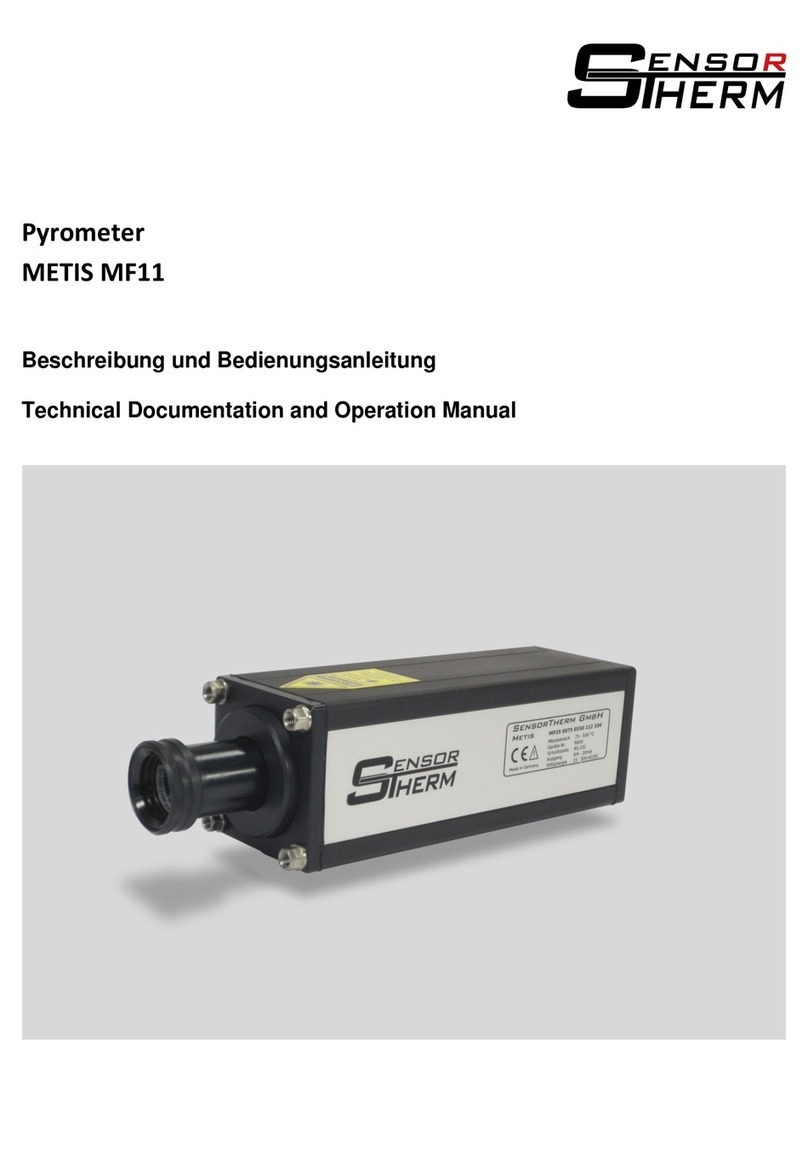
Sensor Therm
Sensor Therm METIS MF11 User manual
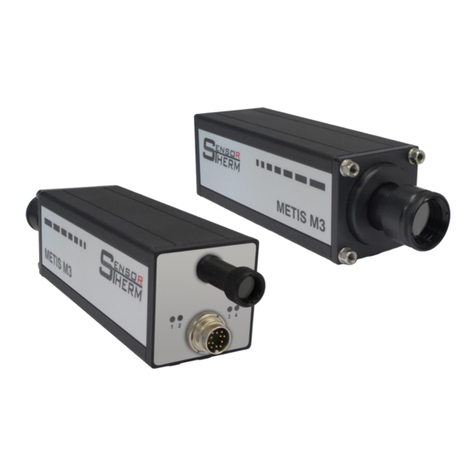
Sensor Therm
Sensor Therm METIS M3F1 User manual
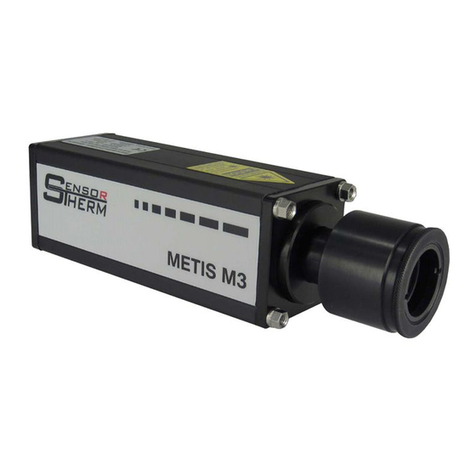
Sensor Therm
Sensor Therm METIS H3 series User manual
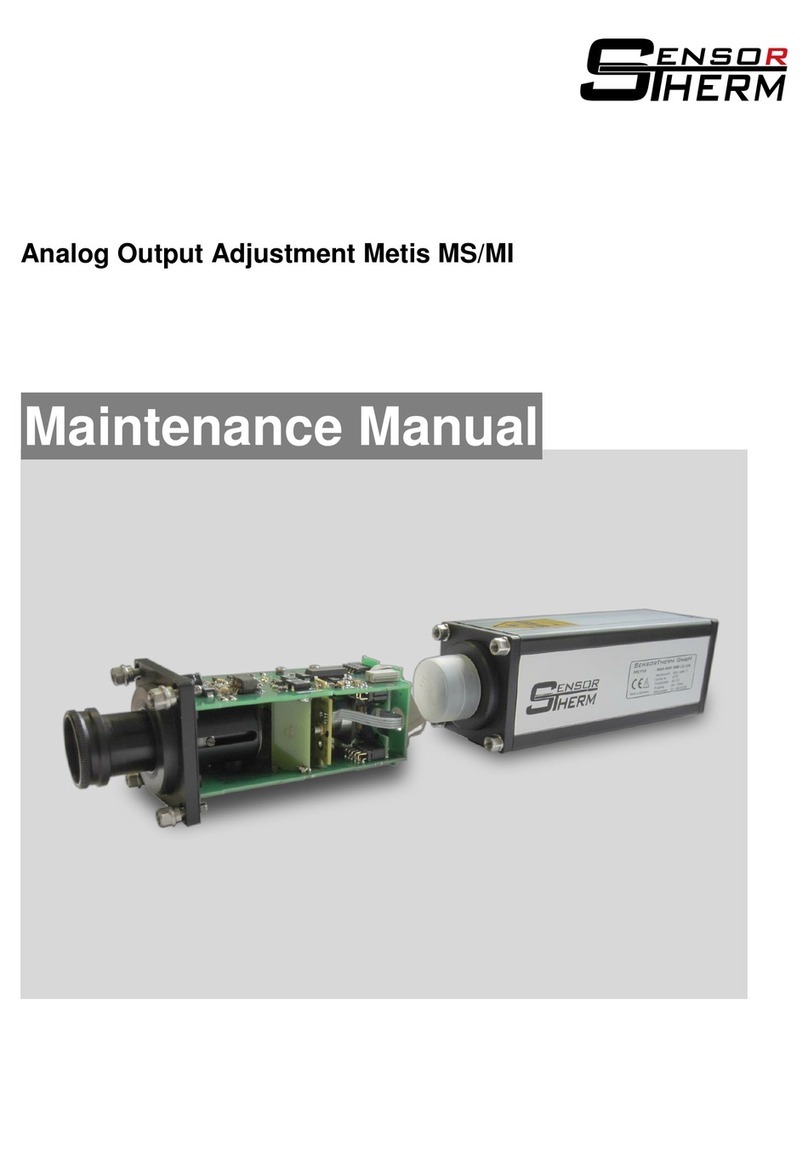
Sensor Therm
Sensor Therm Metis MS User manual
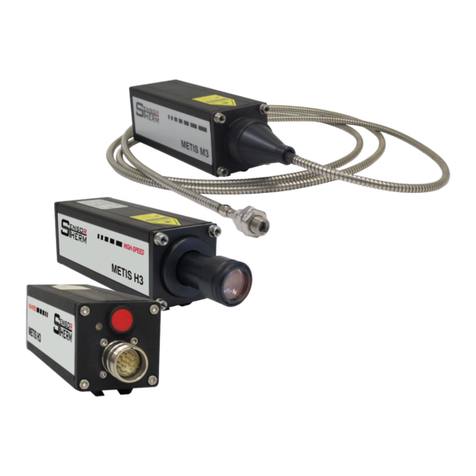
Sensor Therm
Sensor Therm METIS M311 User manual
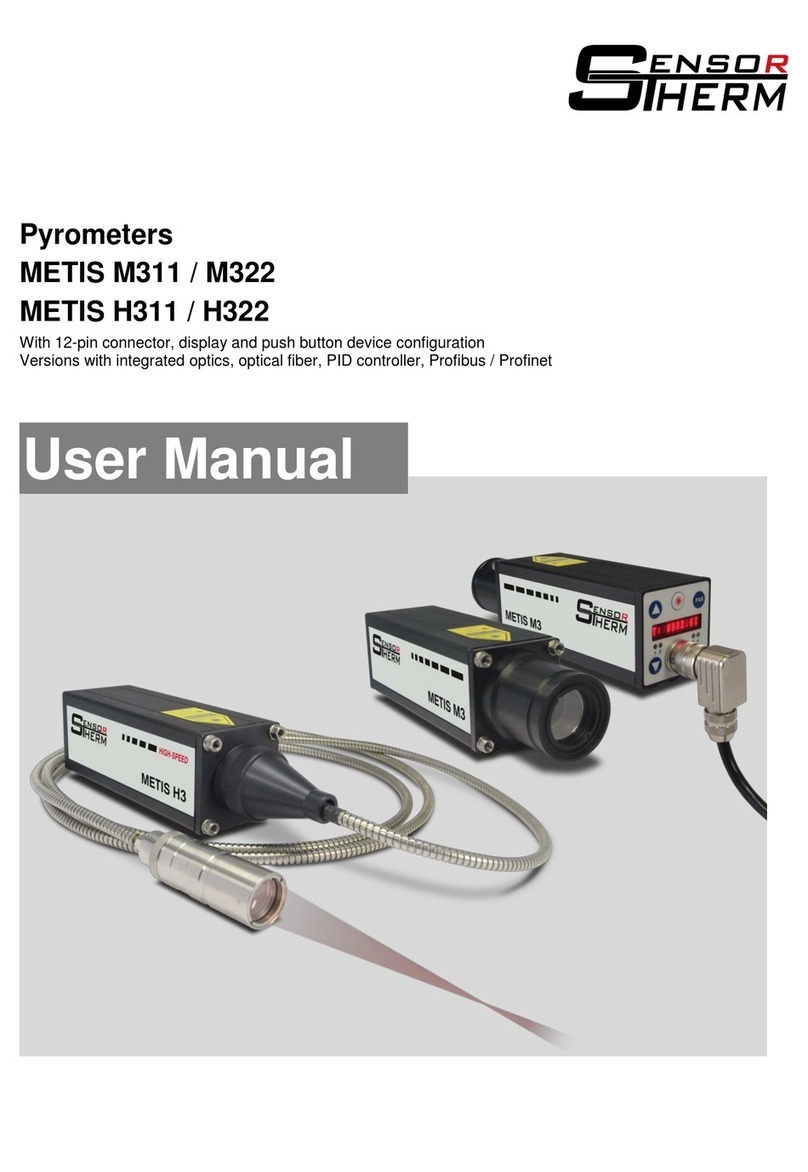
Sensor Therm
Sensor Therm METIS M311 User manual

Sensor Therm
Sensor Therm METIS M311 User manual
